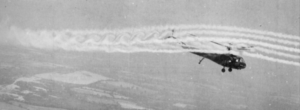This paper will discuss four areas of unsteady helicopter rotor aerodynamics. First, this paper discusses the classical harmonic solutions to rotational aerodynamics and their relationship to the fundamental Theodorsen solution. Second, modern solution techniques are discussed. Finally, the paper describes wake interactions and their noise production implications.
 |
| From: A. R. S. Bramwell, Helicopter Dynamics. New York: John Wiley & Sons, 1976 |
Unsteady helicopter aerodynamics are complicated. An understanding of the governing physics is possible by isolating simplified systems. Early contributions were based on harmonic analysis. These methods predicted the basic governing fluid physics and warned about blade-wake interactions. Most modern solutions are based on discrete flow representations and computational solutions. These solutions allowed high resolution studies of fluid flow at the expense of physical insight. These discrete flow methods confirmed the blade-wake interaction sensitivities. Blade-wake interactions are shown to create intense and directional disturbances.
The helicopter rotor is a fundamentally unsteady aerodynamic process. Rotor analysis goes from simple 1D shed vorticity models to fully 3D transient turbulent experiments. While the fundamentals of unsteady rotor ?ow are known, an overall theory with a closed form solution is clearly impossible. Further developments in unsteady helicopter aerodynamics will continue as long as the helicopter is a viable transportation vehicle.
The full paper is available here.

